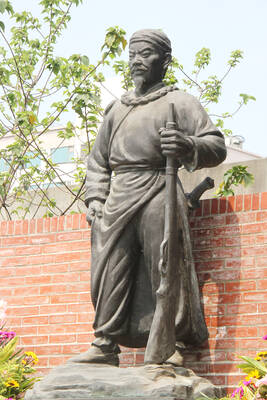Millions of Germans will settle down in front of their TV sets on New Year’s Eve for what has become an annual ritual — the airing of an ancient British comedy sketch starring a long-dead, music-hall comedian.
This year is the 45th anniversary of the broadcast that has become as much a part of New Year’s Eve for Germans as singing Auld Lang Syne is in English-speaking countries. The 15-minute sketch, acted by Freddie Frinton and May Warden, this year will be televised by every major regional public-TV channel in Germany and by a scattering of commercial networks as well.
The black-and-white British slapstick sketch, totally unknown in the English-speaking world, has become the highest-rated TV show in German history, and has spawned fan clubs and a cult following of viewers who stage parties to recreate the sketch at home.
GOLDEN OLDIE
In a nation not exactly known for its ribaldry and thigh-slapping humor, the New Year’s Eve showing of Dinner for One never fails to bring down the house. There are viewers who have memorized every gesture, every line of the English-only sketch.
The mere mention of the tagline “Same procedure as last year, Miss Sophie” will break the ice with the sternest of stern-faced Germans. Mention that line, regardless of the situation, and be prepared for the stern-faced German to reply with, “Same procedure as every year, James,” and then watch the Germans collapse into hysterical laughter.
It is a phenomenon that has become ritualized into tradition. The Dinner for One sketch was originally performed in the 1920s in the British music halls. This 15-minute TV adaptation is performed by 1950s British TV comedian Freddie Frinton and his longtime onstage partner May Warden. In the early 1960s, a German television producer had caught the stage act at Blackpool and invited Frinton to fly back to Hamburg with him to tape the sketch for one-time broadcast in 1963.
Studio employees and in-house secretaries served as the live audience for the sketch about a butler who gets riotously drunk whilst serving food and drinks to his employer, Miss Sophie, and her guests on her 90th birthday.
The running joke is that Miss Sophie is sitting all alone at a table because she has outlived all her male guests — who apparently were her former lovers. Butler James assumes the role of each “guest” in order to toast Miss Sophie with champagne, wine, port and so on throughout the meal. Before each toast he asks plaintively: “Same procedure as last year, Miss Sophie?” to which she responds, “The same procedure as every year, James.”
The “same procedure” gag-line is repeated one final time after dinner as butler James escorts Miss Sophie upstairs to bed, with Frinton leering knowingly at the audience and affirming, “I’ll do me very best!”
After the first broadcast in 1963, the videotape was stored away for about a decade. Then in the early 1970s, the sketch was used as a New Year’s Eve filler on NDR television in Hamburg and proved to be a huge hit. NDR repeated it the next year, and soon other public broadcasters linked up with NDR to air the show as well.
It quickly became a regular part of the German New Year’s Eve celebrations. Parties come to a standstill as guests gather round the television to guffaw at James and Miss Sophie going through “the same procedure as every year.”
Over the years somehow it has become a cult classic in Germany — to the extent that it’s shown on dozens of regional channels at some point over New Year, and NDR shows it six or seven times during New Year’s Eve.
“It usually has the highest rating of any program shown during the year,” says Juergen Meier-Beer, NDR’s head of entertainment. “We have an average market share in our area of 8 percent. Dinner for One gets us up to 20 percent to 30 percent every time. We reckon that one in every two viewers in our area will watch it at some point on New Year’s Eve.”
In recent years it has also been shown in Austria, Switzerland and other countries.
Ironically, Frinton died long before his sketch made his name a household word across central Europe.
Every German alive today knows the entire skit Dinner for One by heart. Most Germans are shocked to learn that the rest of the world is ignorant of this pearl of British humour.
English-speaking visitors to Germany are invariably flummoxed by continual references to this obscure music-hall sketch. In a bid to make casual conversation, a German will ask, “What do you think of Dinner for One?”
“Dinner for one what?” you ask in reply.
“You know — Dinner for One: James, Miss Sophie, same procedure as every year?” And then they break into an uncontrolled fit of giggles.
Given its astounding popularity in Germany, they assume that it must be a huge hit elsewhere in the world — and they feel flattered to have been lucky enough to get in on the big British joke.
SILLY MOMENT OF MERRIMENT
Germans invariably are amazed that few people in Britain under the age of 50 know who Frinton was. In fact, Frinton was a master at playing comic drunks and had a huge following on British television in the 1950s.
He was a bit past his prime when he taped the German version of his popular sketch. Viewed for the first time, the sketch seems dated and stale, an impression not helped by the fact that it was shot in black-and-white and recorded on primitive videotape.
But what Germans love about Dinner for One is the fact that it is a silly moment of merriment that has become enshrined in the nation’s psyche. People remember seeing it when they were young, and with people who are no longer present, and they remember New Year’s Eves of years gone by.
The sketch, of course, improves from repeated viewing, not unlike the Rocky Horror Picture Show and other cult classics.
And on New Year’s Eve, of course, many viewers have been raising their glasses in toasts all evening already and are as smashed as Frinton’s character in the sketch. That makes it easy for the millions of German viewers to slur the lines right along with inebriated butler James, giggling all the while.
On the Net: http://tw.youtube.com/watch?v=Lh_wygDUrxs

One of the biggest sore spots in Taiwan’s historical friendship with the US came in 1979 when US president Jimmy Carter broke off formal diplomatic relations with Taiwan’s Republic of China (ROC) government so that the US could establish relations with the People’s Republic of China (PRC). Taiwan’s derecognition came purely at China’s insistence, and the US took the deal. Retired American diplomat John Tkacik, who for almost decade surrounding that schism, from 1974 to 1982, worked in embassies in Taipei and Beijing and at the Taiwan Desk in Washington DC, recently argued in the Taipei Times that “President Carter’s derecognition

This year will go down in the history books. Taiwan faces enormous turmoil and uncertainty in the coming months. Which political parties are in a good position to handle big changes? All of the main parties are beset with challenges. Taking stock, this column examined the Taiwan People’s Party (TPP) (“Huang Kuo-chang’s choking the life out of the TPP,” May 28, page 12), the Democratic Progressive Party (DPP) (“Challenges amid choppy waters for the DPP,” June 14, page 12) and the Chinese Nationalist Party (KMT) (“KMT struggles to seize opportunities as ‘interesting times’ loom,” June 20, page 11). Times like these can

JUNE 30 to JULY 6 After being routed by the Japanese in the bloody battle of Baguashan (八卦山), Hsu Hsiang (徐驤) and a handful of surviving Hakka fighters sped toward Tainan. There, he would meet with Liu Yung-fu (劉永福), leader of the Black Flag Army who had assumed control of the resisting Republic of Formosa after its president and vice-president fled to China. Hsu, who had been fighting non-stop for over two months from Taoyuan to Changhua, was reportedly injured and exhausted. As the story goes, Liu advised that Hsu take shelter in China to recover and regroup, but Hsu steadfastly

You can tell a lot about a generation from the contents of their cool box: nowadays the barbecue ice bucket is likely to be filled with hard seltzers, non-alcoholic beers and fluorescent BuzzBallz — a particular favorite among Gen Z. Two decades ago, it was WKD, Bacardi Breezers and the odd Smirnoff Ice bobbing in a puddle of melted ice. And while nostalgia may have brought back some alcopops, the new wave of ready-to-drink (RTD) options look and taste noticeably different. It is not just the drinks that have changed, but drinking habits too, driven in part by more health-conscious consumers and